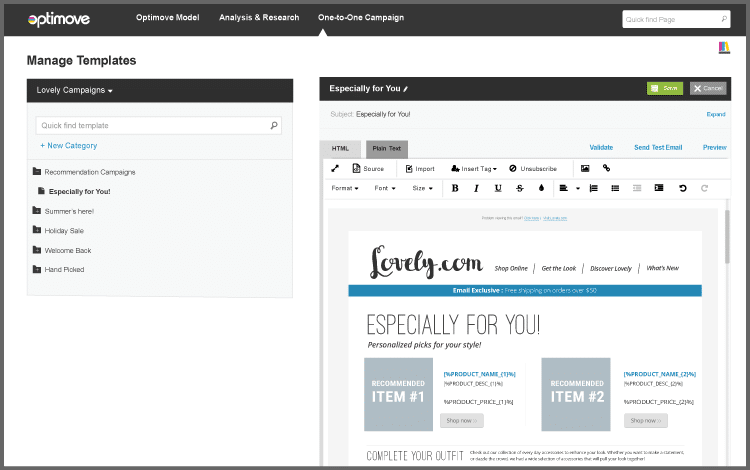
AI and the Retail Marketer’s Future
How AI transforms strategy and processes, driving the adoption of Positionless Marketing
Exclusive Forrester Report on AI in Marketing

Product recommendations are as old as the internet. Well, at least as old as Amazon. Introducing customers to the most relevant content based on existing data is a vertical-wide practice: publications try to introduce the most appealing reads, ecomm sites push forward the most relevant products, and gaming sites offer games and apps that each specific player will find most interesting. Product recommendation campaigns are a powerful way to increase sales, customer satisfaction, customer loyalty and customer lifetime value. The options on the internet are infinite, but for us humans, there are only 24 hours in a day. A user spends an average of 7.5 to 11 minutes on an ecommerce site. If that user browses each item for 10 seconds, by the time he leaves he would have gone through 66 items – a fraction of the items on the site. This means that there’s only a narrow chance the browser will come across the item he was looking for. And that’s only in the case the customer actually knows what he’s looking for in the first place. To frame the problem: the customer engages with the brand for a limited time, and to make the most out of that time the brand needs an algorithm which will match the specific customer and the most relevant products. This will save the customer time and enable the brand to offer products from the long tail which are not immediately visible on the site.
There are two approaches to serving product recommendation: the content based approach, and the collaborative filtering approach.
The content based approach recommends items based on their attributes. This is done by listing different content attributes for each item, and recommending products which share the same attributes with the ones the customer recently purchased.
This works well for items that have actual content, such as books or movies, where we can look at genre, actors, era, type etc., so for a customer who’s watched The Godfather, we might recommend The Sopranos. The paradigm doesn’t work as well for items which have less distinct attributes, for example make-up, dietary supplements, vacations, clothes and so on.
Additionally, with content-based recommendations we run the risk of recommending the same things over and over again, not enabling the customer to widen his or her horizons and to enjoy the serendipitous discovery of items that lie outside their comfort zone.
 Collaborative filtering flips the model around: we start off not with the product’s attributes but with the collective wisdom of the brands’ users, by using data from other customers to predict which items the next customer might like. We assume that people who agreed in the past will agree again in the future.
The pros of this method are ease of implementation (no need to attribute different content values to items), no domain dependency (since the methodology is content-agnostic it can be used across many domains), and serendipity (the chance that the user will come across items which he wouldn’t have looked for independently but will still enjoy).
In some cases, it may be beneficial to use a hybrid approach which looks at both content attributes and filtering.
Collaborative filtering flips the model around: we start off not with the product’s attributes but with the collective wisdom of the brands’ users, by using data from other customers to predict which items the next customer might like. We assume that people who agreed in the past will agree again in the future.
The pros of this method are ease of implementation (no need to attribute different content values to items), no domain dependency (since the methodology is content-agnostic it can be used across many domains), and serendipity (the chance that the user will come across items which he wouldn’t have looked for independently but will still enjoy).
In some cases, it may be beneficial to use a hybrid approach which looks at both content attributes and filtering.
Collaborative filtering can be implemented in two ways: memory based and model based. The memory based method uses all the data in the system, while the model based approach relies on clustering or latent variables to measure similarity between items. The memory based method may be built on a user-to-user approach or on an item-to-item approach. In both cases, we compute the distance between users or items. For the user-to-user approach, for example, we find the k customers who are most similar to the target customer (his “neighbors”), and produce recommendations based on these neighbors’ preferences.
For the new Optimove product recommendation module we used a memory-based collaborative filtering algorithm. This was the perfect fit for our users who work in a variety of domains, from snacks to bags to socks.
Optimove-generated product recommendations help expose customers to products and product categories that they haven’t explored before, but are likely to find appealing. Combined with Optimove’s advanced customer segmentation, product recommendation campaigns enable the creation of hyper-targeted communications that are further personalized for each individual customer. For example: a campaign targeting sale-seekers will be so much more powerful if it showcased not only the general offer, but also specific products that each customer may be interested in and their marked down prize. This added layer of personalization has the potential to capture the hearts of even the most aloof customers in your database.

Exclusive Forrester Report on AI in Marketing
In this proprietary Forrester report, learn how global marketers use AI and Positionless Marketing to streamline workflows and increase relevance.


Writers in the Optimove Team include marketing, R&D, product, data science, customer success, and technology experts who were instrumental in the creation of Positionless Marketing, a movement enabling marketers to do anything, and be everything.
Optimove’s leaders’ diverse expertise and real-world experience provide expert commentary and insight into proven and leading-edge marketing practices and trends.


